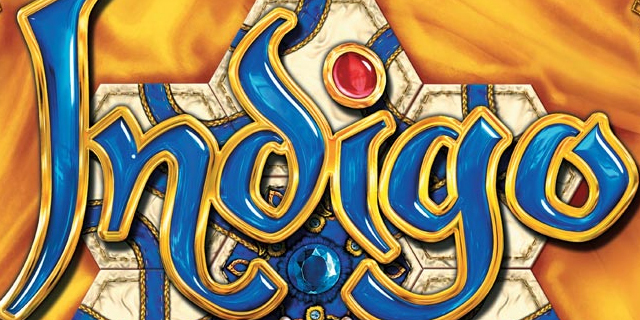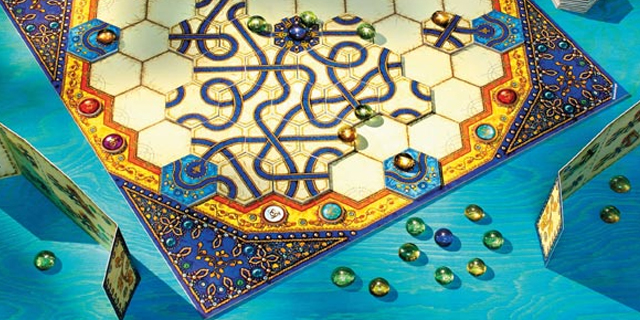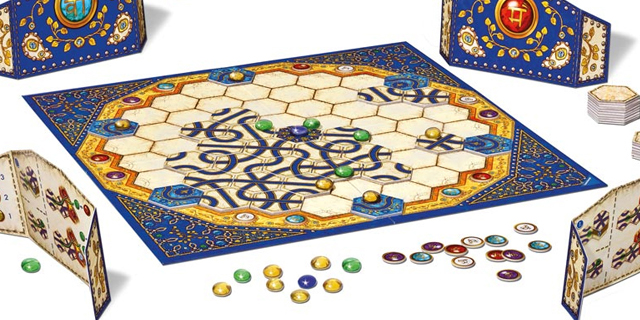
One of the first games I purchased at my then-new FLGS was Tsuro, a simple tile-laying game that challenged players to not fall off the edge of the board as the ever-winding path they laid in front of their pawn took numerous twists and turns. It supports up to eight players, has zero text, has a pleasing aesthetic, and barely takes more than fifteen minutes regardless of the number of people involved. As such, it is less of a game and more of a palette cleanser between actual games. With no real strategy other than “don’t commit suicide until you can no longer avoid it,” it is one of those titles that I really couldn’t talk about in this space without maybe dedicating a column to multiple quick-bite games… unless I had an ulterior reason to bring it up, like now.
Using similar mechanics to Tsuro, Reiner Knizia’s Indigo (published in the US by Ravensburger) is slightly more challenging in the strategy department and, while still fairly brief in the play time department, a more solid filler-level experience. Each player is assigned two or three sides of the hexagonal board as goals; two-player games have three goals each, three players each get one goal of their own and one shared with each opponent, and with four each player’s goal is shared with a different opponent. Placed at the spaces between these goals are treasure tiles, each bearing as single one-point yellow gem. Another treasure tile lies in the center of the board, containing five two-point green gems and one three-point blue one. A stack of hexagonal tiles are shuffled up and each player receives two (one if you’re using the basic rules, but there’s no reason to do that unless playing with young children). Each tile bears three paths connecting the sides on it in some combination of sharp turn, wide turn, and/or straight line.

On a player’s turn, they place one of their tiles anywhere on the board, with the exception that two exit points on a goal cannot be connected by a single sharp turn (the board has a visual reminder of this). Should a tile be placed adjacent to a tile bearing one or more gems, the gem(s) will follow the path until one of three events occur: 1) it reaches the end of the path as laid out, at which point it stops; 2) it reaches an exit point of a goal, at which point the player(s) owning that goal score(s) it, placing it (or a duplicate) behind their screen; or 3) it collides with another gem, at which point both are removed from the board and nobody scores them. Only one gem leaves the center treasure tile per tile placed next to it, with the five green gems going first and then finally the blue one only when the sixth tile is placed next to the center. After movement and scoring (if any), the player then draws a new tile and the turn passes. The game ends when all gems have been removed from the board. Highest score wins, with ties being broken by whomever collected the most individual gems.
The tension that comes from sharing goals with your opponents is what drives the strategy behind playing tiles. Especially in the four-player game, where every point you score is also being scored by one of your opponents (I have yet to play with three and will probably never play with only two, as that sounds less engaging). The trick is to spread that around enough so that you come out on top when the smoke clears. Of course, you only have two choices of tile to place each turn (unless you have drawn the same tile twice, which happens), but since any vacant space is usually a legal play you certainly have options.

Each goal only has six exit points, and while it is not legal to connect two of these with the same tile, there’s nothing in the rules against connecting them with several, which can limit some scoring opportunities and force more gems to head in your direction. Occasionally you might also need to weigh the option of eliminating two gems, which is something I would only do if I were very sure that I was in the lead – or maybe could get there if my opponents didn’t score those two gems. Turn order is also important, as sequential players can sometimes work together if a gem happens to be heading toward their mutual goal. Conversely, every player between you and your “partner” can and probably will take the opportunity to mess with your plan and steer things in a different direction.
A game of Indigo should rarely take longer than twenty minutes, and that includes the set-up of shuffling tiles and assigning goals (the instructions give a recommended assignment, but you could experiment with others). My only complaint about the game is the lack of a bag for drawing tiles, but that is a very minor issue. Surpassing the low strategic bar set by Tsuro is not exactly a selling point, but any group that enjoys a quick game of Tsuro now and then will probably appreciate what Indigo brings to the table as well.
Indigo retails for around $35.



















